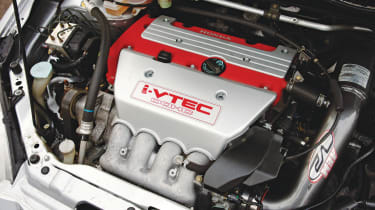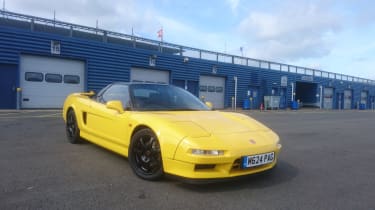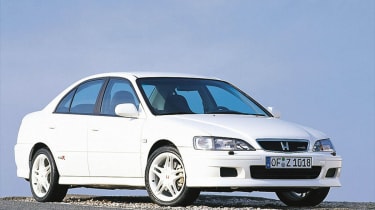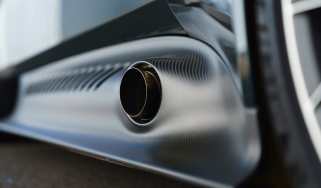What is Honda Type R? Greatest cars and 25-year history of Honda’s performance brand
Here’s everything you need to know about the Honda Type R sub brand along with its best cars from Accord and Integra to Civic.
Can it really be 25 years? Honda’s Type R brand has emerged from relative Japanese market obscurity to become a revered international performance car icon in an impressively short amount of time. Its rise to prominence has been built on a line of driver focused fast Hondas that have never really strayed too far from the winning Type R formula.
Honda is a company with deep motorsport and engineering heritage dating back to well before Type R or VTEC branding appeared - the marque constructed some of the greatest racing engines of all time. Type R distilled those years of racing knowledge, feeding it into a series of high-revving performance road cars – appealing to every enthusiast driver’s inner touring car ambitions.
Here we document the history of Honda Type R, exploring the cars that have worn the badge and looking in detail at those that we’ve been lucky enough to receive in the UK.
Honda’s motorsport story
Honda’s time in Formula one is chequered, but, when times were good they were great. Honda entered the sport in 1964, competing for four years in which results never met expectations. In 1968, to focus all efforts on the development and manufacturing of passenger cars, Honda ended its brief association with the sport.
Fifteen years on (1983) Honda was back as an engine supplier and hitting its stride, powering Williams and then McLaren onto six consecutive constructors championships, steamrolling the (first) turbocharged era between 1986 and 1991. The FW11 chassis’ 1.5-litre RA166-E of 1986 morphed into the RA167-E a year later, both served William’s admirably before McLaren started to reap the benefits of a tie-up with Honda.
It was the 1988 season when Honda peaked – the turbocharged V6 (codenamed RA168-E) was the lynchpin of the McLaren MP4/4 car that dominated all season. Ayrton Senna and Alain Prost collected a remarkable fifteen poles and victories in sixteen races under Honda power. In its engine supplier capacity, Honda claimed sixty-nine victories in one-hundred and eighty-seven races in eight years.
What does Type R mean?
The big red ‘R’ denotes a road-going Honda model’s racing credentials, and when Honda pins it to the boot it’s drawing the line back to its famous exploits on the track. The R seal indicates a focused engineering philosophy manifesting itself in specific ‘Type R’ features: snickety gearboxes, free-revving engines and intense driving experiences all characterise the brand. The combination of these Type R hallmarks has given the automotive world some legendary cars over the years.
VTEC - variable valve timing technology
You can’t talk fast Hondas without mentioning VTEC (Variable Valve Timing and Lift Electronic Control): a product of Honda’s R&D drive in the 1980s. The Japanese marque embarked on its ‘New Engine Concept’ programme to minimise the trade-off between economy and performance and this innovative way of controlling the engine’s behaviour at was the result.
In basic terms, the technology worked by using two camshaft profiles, one for higher rpms the other for lower. The higher rpms would induce the changeover to higher lift on the camshaft, letting more air into the engine via the valves leading to more power being produced. The innovative timing technology allowing for the faster crank speeds, once reserved for supercars, created much of the appeal behind the Type R brand.
The cars
The first Type R production car: Honda NSX Type R
In 1992, Honda took its capable supercar and dispensed with many of the amenities that lent the NSX the ‘everyday supercar’ accolade.Outright performance was promoted far higher up the list of priorities. and Honda’s engineers efforts yielded the NSX Type R.
At 1230kg, some 120kg lighter than the standard car – courtesy of thinner rear engine cover glass, the removal of the airbagand a complete lack of sound insulation – the absence of any extra oomph from the engine proved no great loss. The 3.0-litre V6 was maxed out at 276bhp under the agreement between Japanese manufacturers to cap power outputs in the name of safety.
The shortened gearing and palm-friendly, Type R titanium gearknob encouraged you to slice through the five-speeder and ring out every rpm in order to extract the VTEC engine’s performance. Suspension was stiffened significantly, with some extra body strengthening, taking grip and handling to new levels.
> Click here for our Honda NSX review
The NSX Type R was painted Championship White – just like Honda’s first Grand Prix-winning car of 1965 – and fitted with a pair of red Recaro seats, setting the mould for everything to come...
The first UK Type R: DC2 Honda Integra Type R
The new ‘Spec-R’ engine was hand assembled, with polished ports, lighter conrods, stronger pistons, re-shaped intake valves and a larger throttle body all adding up to 187bhp at 8000rpm – or an incredibly impressive 104bhp per litre. Coupled with shorter gearing, the Integra could hit 62mph in just 6.2sec, topping out at 145mph.
To make the most of the powertrain, Honda took the Integra down to its raw ingredients, rebuilding it from the ground-up with absolutely no flab. Sound insulation was stripped to a bare minimum, the wheels were significantly lighter and – perhaps coolest of all – the windscreen was thinner and lighter than the standard car’s. The Type R was braced with extra seam-welded sections in the shell, as well as front and rear strut braces.
For 1998 Honda imported a small run of UK-market Type Rs. Only offered in Championship White with red Recaro seats early on, other colours such as black and red could be specified later.
What we said: evo 095
Back in issue 095, we brought together the 15 greatest front-drive cars of recent times. The Integra was the overall winner. As Richard Meaden concluded, ‘It’s a car as sweet and all-consuming as any I’ve experienced at any price, and as pure and focused in its own way as any Porsche RS. Forget the accolade of greatest front-wheel-drive car. The Integra Type R ranks as one of the truly great drivers’ cars of any kind.’
The family sized Type R: CL1 Honda Accord Type R
Honda knew it was onto a winner with Type R after the initial success of the Integra (as well as the Japanese-market only EK9 Civic) the company followed it up with a hot version of the UK-built Accord. Here was a lighter and more powerful family saloon car – making the most of Honda’s motorsport expertise. While this UK-built Type R might not have been built with homologation in mind, like the Integra, nobody bothered to tell Honda’s engineers.
The Accord Type R was conceived in a similar vein to modern hot hatches, serving a dual purpose to satisfy practicality and driver enjoyment. Perhaps not the truest Type R in spirit, it still took on the brand’s aura. The 2.2-litre made its 212bhp and 158lb ft at similarly high rpms, 7,200 and 6,700 respectively – a light-spinner indeed. A LSD sat between the 17-inch alloys upfront, to keep all 1,306kg locked on line.
What we said: evo 012
On the fast, sweeping but occasionally lumpy and camber-unfriendly roads, the degree of structural integrity these measures bring to the party is extraordinary. The Accord Type R is one of those rare cars that doesn't have to sacrifice control for comfort; it has both. Its firmness keeps the Potenzas planted to the tarmac but doesn’t allow sharp inputs to upset the body’s composure. Very special indeed.
The breakthrough Type R: EP3 Honda Civic Type R
While the Type R name was well recognised among knowledgeable petrolheads, it’s fair to say that the success of the EP3 – the first of the European-market Type R to wear the Civic name – thrusted it into the mainstream.
The one-box profile birthed the breadvan nickname and helped it establish a cult following during its production years and that remains today. Certainly less garish aesthetically than subsequent Type R’s, it still harboured the R factor. The gear lever protruding from the dashboard looked odd but was an ingenious ergonomic touch: compressing the distance from steering wheel to titanium knob for lightning fast shifts of the six-speed manual.
> Click here for our Honda Civic Type R EP3 buying guide
The K20 powerplant was detuned for the UK market, making do with 197bhp as opposed to the JDM car that squeezed out 209bhp. The 2.0-litre motor was still unique among hot hatches with it’s frenetic and frantic VTEC engine. 0-62mph was thus dealt with 6.8sec and a top speed of 146mph was possible.
What we said: evo 035
The 6000rpm kick is slightly softer, while the manic howl is less spine-tingling. It’s still fiercely accelerative if you keep it on the boil, and although it doesn't sound quite as angry as Type-Rs of the past there’s a bit more meat on the mid-range should your concentration lapse and the revs drop below five grand or so.
The spaceship Type R: FN2 Honda Civic Type R
All show and no go? The FN2 arrived in 2007 with a much rounder design, as far from the breadvan as you could get. The futuristic looks came with a suitably futuristic nickname, ‘the spaceship’. The dramatic transformation was largely superficial, in dynamics and performance terms the FN2 offered negligible evolution.
The K20 from the EP3 was revised, producing a single extra horsepower and 3lb ft of torque less (Honda claimed it delivered smoother performance with a less profound VTEC crossover). The VTEC bark though was still alive and well once you swept past 5400rpm on the tachometer. This though only masked the issues of a car one-hundred-plus kilos heavier than its predecessor. When we tested the FN2 against its period rivals it didn’t fare too well.
What we said: evo 102
While the gearshift isn’t quite as snappy as that of the last CTR, it’s still one of the best here. Less satisfactory is the chassis, which starts off feeling alive and responsive but rapidly loses its brightness. Some minutes later when I join the rest of the team at our rendezvous point, I’m still trying to fathom just why the Civic feels uninspiring.
The ‘ring master Type R: FK2 Honda Civic Type R
Honda fought off turbocharging for a long time, but with the demise of the naturally aspirated Type R the brand lingered in limbo. The Type R hiatus concluded with the FK2’s arrival. It showed glimpses of the FN2 in its visage and the outlandish exterior split opinion. The blistered arches, conspicuous rear wing and pronounced diffuser housing a quartet of exhausts were a hint the Type R was back and with purpose.
Honda took its first turbocharged Type R to the Nurburgring where all modern hot hatches must earn their stripes. 306bhp and for the first time in a Type R a healthy slug of torque – 295lb ft available from 2500rpm– propelled the Civic through the Eifel Forest in 7min 50.63sec. This CTR could be filed under hardcore in the Type R ranks pandering to performance rather than refinement.
What we said: evo 212
You can adjust its balance by trail-braking into corners or by lifting sharply mid-turn, which makes it involving and playful. Over the course of the test it becomes clear that the Type R is a peaks and troughs sort of car. In many ways it’s very good indeed and at times you completely fall for the way it hauls itself down a road, but at other times it comes up short against the very accomplished opposition.
Today’s Type R: FK8 Honda Civic Type R
The FK8’s release ended a short production run for the previous model. The extroverted design theme present on the two previous Type Rs was continued. The huge wing remains as does the busy bodywork that creases and folds all the way down the length of the car from panel to panel. The numerous strakes and slats serve a functional purpose reducing lift and manipulating airflow toward the rear wing to generate downforce.
> Click here for our review of the latest Honda Civic Type R
Among today’s modcon laiden hatches, the 1,380kg kerbweight means the Type R is one of the lighter cars in class. It pulls from standstill to 62mph in 5.7sec extracting all 316bhp from the single scroll turbocharged 2-litre (lightly refreshed from the previous model). The excellent six-speed manual transmission directs power to a LSD that apportions power at the front wheels. Thankfully the current Type R is equipped with a fully independent rear end unlike the torsion beam underpinning the FK2.
We are yet to put the Type R though the its paces, but our initial driving has us looking forward to more. Honda has sanded off the FK8’s unnecessarily hard edges instilling a modicum of civility without suppressing the race-bred character that’s drawn so many to the famous sub-brand. Read the web review here.
The JDM Type R exclusives
The catalogue of Type Rs reads quite a bit longer in Japan. Over 25 years of Type R the UK market missed out on a quartet of models.
The first was the inaugural Civic Type R, the EK9. An impressive specific output of 114bhp/per litre and lightweight monocoque chassis proved this Type R was no ordinary hot hatch and wasn’t a performance car created solely through the fitment of a large engine.
The sequel to evo’s greatest ever front-driver (awarded in issue 095) the Integra DC2 didn't make life too easy for its successor, the DC5. The DC5 made improvements in all areas of the spec sheet, boasting a stiffer chassis, more power but also more refinement. A great car in its own right, people still feel the original Integra is the truer and rawer Type R of the two.
The rise of the hot hatch on our shores probably saw Honda strike the UK market from the list of countries receiving the second generation Accord Type R. This car certainly subscribed to the more muted school of performance saloon styling, mirroring the look of the basic Accord with only subtle Type R cues pointing towards its sporting pretensions. Recaro seats, a LSD and tall – 8300rpm – redline bestowed it with the typical Type R hallmarks.
The last Type R to escape the battered British B-roads was the FD2. The exterior wouldn’t be unfamiliar to UK road users, the hybrid Honda Civic IMA wore the same basic body shell without all the angry Type R trinketry. Under the skin though it was a full-blooded Type R and one we lament missing out on.

















